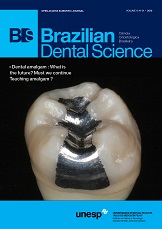Wear of depth perception and shade matching outcome in the pre-clinical setting
DOI:
https://doi.org/10.14295/bds.2015.v18i1.1049Abstract
Objective: the present study aimed to investigate whether dental wear depth perception has influence on the final quality of aesthetic direct restorations in the pre-clinical setting. Material and Methods: eighty one participants were assigned to one of three groups (n=27): G1, beginning dentistry students; G2, intermediate dentistry students; and G3, advanced dentistry students. All groups were required to prepare a tooth for facet of 1mm in depth. Subsequently, teeth were restored with opaque or translucent composite resin. Results: dental wear was different among the groups (p<0.05). G1 obtained a median of 1mm, G2 obtained a median of 0.5mm, while G3 obtained a median of 0.8mm. G3 presented more consistent accuracy in dental wear. Color values did not vary according to the dental wear depth or to the type of resin composite used in the restoration (p> 0.05). Conclusion: technical training and clinical experience contribute to the better dental wear depth perception of undergraduate dental students. No direct correlation between the dental wear depth perception and the quality of shade matching of restored artificial teeth could be performed in the pre-clinical environment.
Keywords: Dental education; Motor skills; Color; Dental Aesthetics
Downloads
Downloads
Published
How to Cite
Issue
Section
License
Brazilian Dental Science uses the Creative Commons (CC-BY 4.0) license, thus preserving the integrity of articles in an open access environment. The journal allows the author to retain publishing rights without restrictions.
=================




























